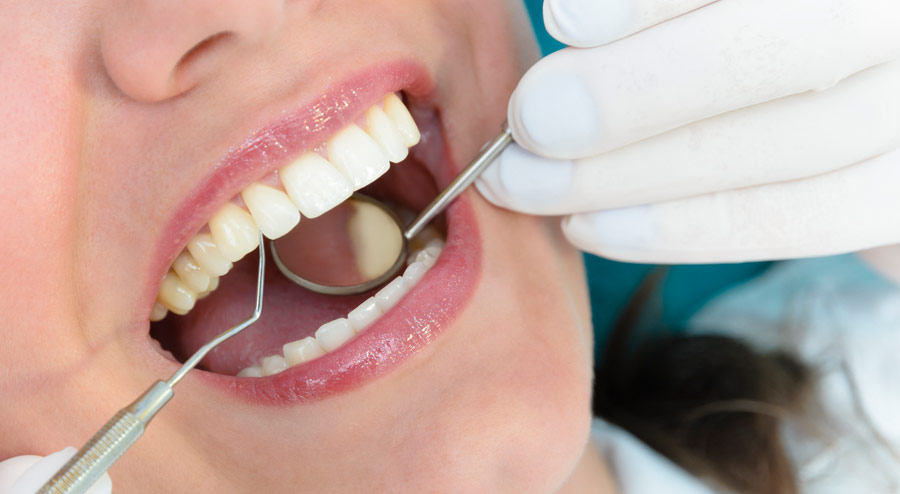Bone Loss in Teeth: Have a Bone Loss around Your Teeth?

It can be difficult to notice the first symptoms associated with bone loss. How can you recognize if you do have bone loss around the teeth?
Causes of Bone Loss around Teeth
There are several reasons why bone loss occurs around the teeth. It can be caused by personal care habits, by disease, or from previous dental work. The main causes of bone loss include:
Periodontitis
Also known as gum disease, periodontitis is one of the most common causes of bone loss around the teeth. Periodontitis always starts out as gingivitis with symptoms such as irritation, bleeding gums, and red gums. If it is left untreated, it will progress into the more serious periodontitis.
Periodontitis is caused when there is a build-up of bacteria in the mouth, dental plaque. This is a serious concern because periodontitis is the main cause of tooth loss in adults. The inflammation and other symptoms, if not treated sooner, destroys the support structures around the tooth, including the bone. The affected teeth will need likely need to be extracted if they have not fallen out beforehand.
The disease also causes the breakdown of periodontal tissue and the alveolar bone. The periodontal tissue is made up of the ligaments that hold each tooth to the alveolar bone. The alveolar bone is what supports the teeth, providing the ridges where the teeth are set. This breakdown is what destroys the bones and causes the tooth to fall out if it is not treated.
Osteoporosis
Osteoporosis is a common disease where bones become brittle due to less bone density. According to the National Osteoporosis Foundation,54 million Americans are living with osteoporosis and a low bone mass. While osteoporosis has a wide range of complications, it is believed to progress periodontitis, according to the US National Library of Medicine.
Osteoporosis is typically first diagnosed when the disease has caused so much bone density loss that it leads to a fracture or break. The dentist is often the first person to suspect osteoporosis in a patient.
The loss of bone density in the alveolar bone caused by osteoporosis can loosen teeth by decreasing their support and eventually cause a tooth or several teeth to fall out. Osteoporosis often leads to periodontitis.
Previous Tooth Extractions
When an adult tooth is extracted but not replaced, it can lead to bone loss. The alveolar bone can deteriorate and resorb and release the minerals into the bloodstream. This is because embedded teeth, whether they are natural or replacements, stimulate the bone when chewing and biting. When the bone is not stimulated, the body recognizes it is not needed and begins to break down the tissue and bone.
Dentures
Dentures can also lead to the deterioration of the alveolar bone. Unanchored dentures are situated on top of the gum line, meaning that there is minimal stimulation to the alveolar bone. This lack of stimulation can cause the bone to deteriorate and resorb which will cause dentures to become loose. Furthermore, people with bridgework can experience bone loss in the area where the missing teeth do not have direct stimulation from chewing as well.
How to Spot Bone Loss
Bone loss is typically a gradual process that can be caused by a variety of issues as previously mentioned. The beginning symptoms can be easily overlooked which leads to progressed bone loss.
Some of the symptoms to look out for include:
- Bleeding gums
- Inflammation and redness of gums
- Painful gums
- Bad breath
- Gum recession (teeth look longer)
- Widening spaces between teeth
- Teeth become unaligned
- Discolored bio-film over the teeth
- Loosening of a tooth or teeth
Risk Factors
There are 700 species of bacteria living in the mouth that are normal and sustain a healthy environment. Some conditions and lifestyle choices can cause this balance to change, negatively impacting oral health. Some of the biggest risk factors for bone loss around the teeth include:
- Poor dental hygiene
- Poor diet
- Diabetes
- Smoking
- Post-menopausal women
- Genetic factors
- Hormonal changes
- Cancer
Treating Bone Loss in Around the Teeth
Depending on the severity of your bone loss the treatments will vary. Someone with gingivitis or the beginning stages of periodontitis can halt the progression of the disease with a proper dental cleaning and improving their oral care routine at home. Three non-invasive treatments are most common for non-advanced periodontitis:
- Antibiotics
- Scaling
- Root Planing
Most often bacterial infections need to be dealt with using antibiotics. Topical antibiotics such as mouth rinses or gels are used to tackle the bacteria that harbor in between the teeth and gums. To ensure that all bacteria causing the infection is removed, an oral antibiotic may be prescribed as well.
An easier method is scaling which involves the dentist using a tool to remove the tartar, plaque, and other bacteria from the surface of your teeth and gums. It goes hand-in-hand with root planing which involves the dentist using a tool that removes bacteria, tartar, and plaque from below the gum line. It smooths the root of the tooth and aids in the gums reattaching to the tooth.
Surgery is another form of treatment if there is significant bone loss. One of the most common surgeries is a bone graft; this is used for a dental implant placement. The bone graft can prevent tooth loss by securing the affected tooth or teeth in place. It also stimulates the alveolar bone where there has been bone loss to regrow, and this allows the restored, healthy bone to replace the graft.
Take Precaution
It is important to go to the dentist regularly for check-ups and cleanings. This makes it easier to find any concerning changes to the gums and teeth, likely catching any diseases in the beginning stages. Most of the causes of bone loss can be prevented by brushing at least twice a day followed by flossing.
Mouthwash can get between the teeth and kill off any harmful bacteria. If you believe you may be experiencing bone loss around your teeth, do not hesitate to make an appointment with the dentist.
Relate Posts to Read:
Hyperdontia: What Is It and How Is It Treated?


